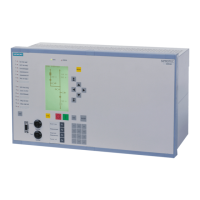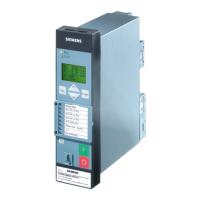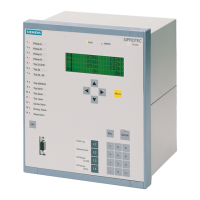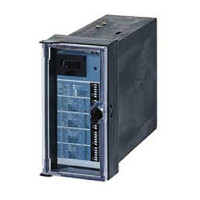But for the user-defined characteristic, you can choose in address 112 and 113 whether to specify only the
pickup characteristic (User Defined PU) or the pickup and the dropout characteristic (User def.
Reset).
Additionally, the superimposed high-current elements 50-2 and 50-3 are available in all these cases. Time
overcurrent protection may be set to Disabled during configuration.
For directional time overcurrent protection, the same information that was entered for the non-directional
time overcurrent protection (except the 50-3 element) can be entered under addresses 115 67/67-TOC and
116 67N/67N-TOC.
For the (sensitive) ground fault detection, the methods of measurement cos φ / sin φ or V0/I0 φ mea.
for direction determination can be set via the parameter 130 S.Gnd.F.Dir.Ch The cos φ / sin φ
method (via residual wattmetric current detection) is set by default. If the cos φ / sin φ measurement
method is set, select between a definite time (Definite Time) characteristic, inverse time characteristics
TOC IEC or TOC ANSI, one User Defined PU and two logarithmic inverse characteristics at address 131
Sens. Gnd Fault. The setting V0/I0 φ mea. provides the definite time characteristic Definite Time.
When selecting the setting Disabled, the entire function is disabled.
For the intermittent ground fault protection, you can specify the measured quantity (with Ignd, with 3I0
or with Ignd,sens.) to be used by this protection function at address 133 INTERM.EF.
At address 134 Dir. Interm. EF you can set the directional intermittent ground fault protection to
Enabled or Disabled.
For negative sequence current protection, address 140 46 is used to specify whether the tripping characteris-
tics should be Definite Time or TOC ANSI or TOC IEC, or whether the function is to be Disabled.
For overload protection, address 142 49 allows you to specify whether the thermal replica of the overload
protection will account for a coolant temperature or ambient temperature (With amb. temp.) or not (No
ambient temp), or whether the entire function is Disabled.
At address 155 27/Q-Protection you can set the QU protection to Enabled or Disabled.
Up to four function groups are available for the synchronization function (only one for 7SJ62). The parameters
161 25 Function 1 to 164 25 Function 4 indicate whether a synchronization function is Disabled or
Enabled. The latter is determined by selecting the operating mode ASYN/SYNCHRON (closing takes place for
asynchronous and synchronous conditions) or SYNCHROCHECK (corresponds to the classical synchrocheck
function). 7SJ62 only provides the function SYNCHROCHECK.
For the circuit-breaker maintenance function, several options are available under address 172 52 B.WEAR
MONIT Irrespective of this, the basic functionality of the summation current formation (ΣΙ procedure) is always
active. It requires no further configurations and adds up the tripping currents of the trips initiated by the
protection functions.
When selecting the ΣI
x
-procedure, the sum of all tripping current powers is formed and issued as a reference
value. The 2P procedure continuously calculates the remaining lifespan of the circuit breaker.
With theΙ
2
t-procedure, the square fault current integrals are formed via arc time and are issued as a reference
value.
For more detailed information about the circuit breaker maintenance procedures, see Section 2.25.2 Statistics.
At address 181 L-sections FL you can set the number of different line sections (max. three) to be taken
into consideration by the fault locator.
When using trip circuit supervision, address 182 74 Trip Ct Supv allows you to select whether this func-
tion should work with two (2 Binary Inputs) or only one binary input (1 Binary Input) or if the func-
tion is Disabled.
If you want to detect an ambient temperature or a coolant temperature and send the information e.g. to the
overload protection, specify the port to which the RTD-box is connected in address 190 RTD-BOX INPUT. In
7SJ62 port C (service port) is used for this purpose; in 7SJ64 it can be either port C (service port) or port D
(additional port). The number and transmission type of the temperature detectors (RTD = Resistance Tempera-
ture Detector) can be specified in address 191 RTD CONNECTION: 6 RTD simplex or 6 RTD HDX (with one
RTD-box) or 12 RTD HDX (with two RTD-boxes). Implementation examples are given in the Appendix (under
"Connection Examples"). The settings in address 191 have to comply with those at the RTD-box (see Section
2.22.2 Setting Notes, side title “RTD-box Settings”).
The flexible protection functions can be configured via the FLEXIBLE FUNC. parameter. Up to 20 functions
can be created. This is done by setting checkmarks at the functions (see the example in Section 2.20 Reverse-
Functions
2.1 General
SIPROTEC 4, 7SJ62/64, Manual 33
C53000-G1140-C207-8, Edition 08.2016

